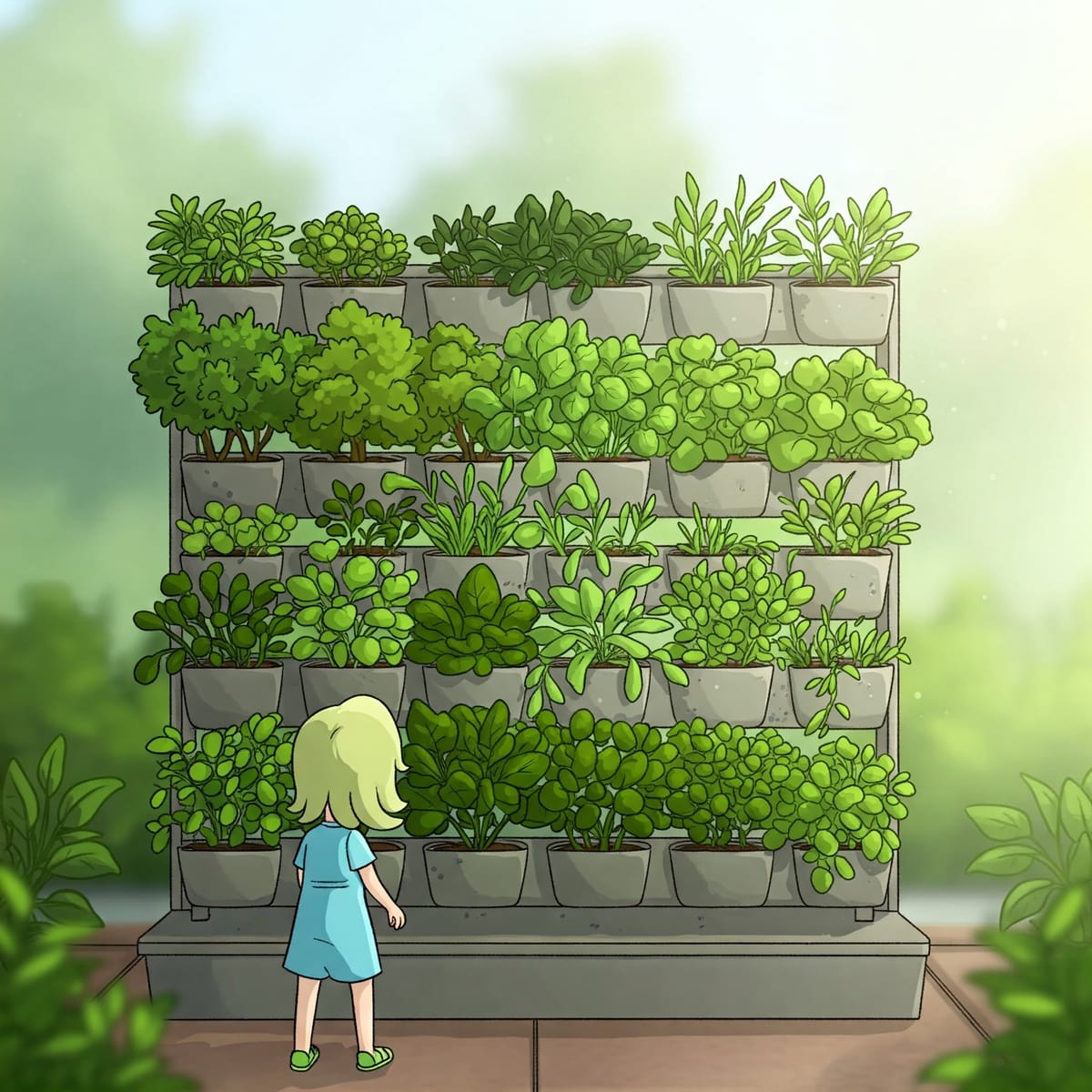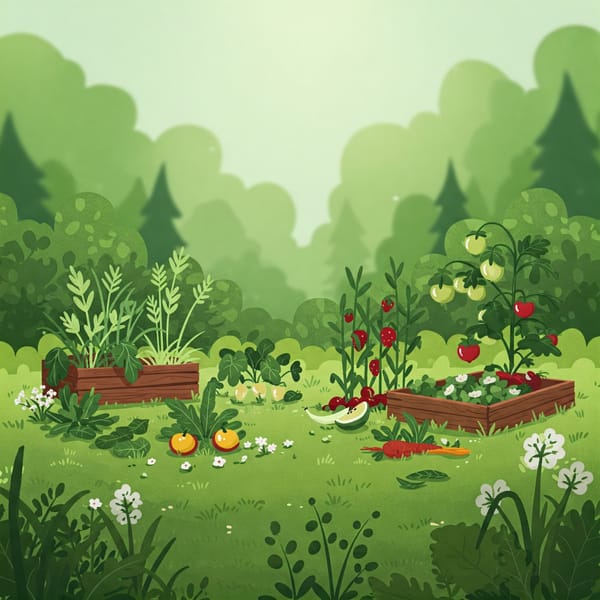Vertical Garden Yield Maximization

TLDR
Vertical gardening is an innovative approach to food production that maximizes yield in small spaces, particularly in urban environments. It involves growing plants in vertically arranged systems and offers numerous benefits, including space optimization, increased yield potential, improved air quality, and reduced water usage. While there are limitations such as high initial costs and the need for specialized equipment, vertical gardening presents a promising solution for enhancing food security and promoting sustainable agriculture.
Vertical Garden Yield Maximization
Introduction
The rise of urbanization and the resulting decrease in available land have led to the development of innovative food production methods, with vertical vegetable gardening becoming increasingly popular. This method involves growing plants in vertically arranged systems, optimizing space utilization and providing a unique way to improve food security in densely populated areas. This report explores the various aspects of vertical vegetable gardens, including their history, systems, benefits, limitations, growing mediums, suitable vegetables, design, irrigation, yield maximization, pest management, lighting, and case studies.
History and Evolution of Vertical Gardening
Vertical gardening is not a new concept; its roots can be traced back to ancient civilizations. The Hanging Gardens of Babylon, built in the 6th century BCE, are an early example of the aesthetic and engineering possibilities of vertical cultivation. Ancient Asian cultures also used traditional methods to grow plants on vertical structures, demonstrating an early understanding of space optimization and sustainable food production. In the Americas, the Mayan civilization developed terrace farming to cultivate crops on steep slopes, effectively using vertical space to prevent soil erosion and manage water resources. Ancient China also featured tiered gardens, integrating nature and architecture. These historical examples highlight the long-standing human effort to incorporate greenery into urban environments and enhance food production through vertical methods.
The modern concept of vertical farming, a more intensive and technological approach, emerged in the early 20th century. While Gilbert Ellis Bailey coined the term in 1915, the first built examples appeared in Armenia in 1951 for space exploration research. Dickson Despommier's idea of skyscraper farms in 1999 significantly influenced the contemporary understanding of vertical farming. This vision spurred innovation, leading to the development of various vertical farming systems in urban centers worldwide. Architect Ken Yeang further contributed by advocating for mixed-use bioclimatic skyscrapers that integrate living units with food production. The early 21st century saw a surge in architectural designs and media attention, solidifying vertical farming as a potential solution to urban food challenges. The evolution from ancient techniques to modern, technology-driven systems reflects a continuous pursuit of maximizing food production in limited spaces, driven by increasing urbanization and the need for sustainable agricultural practices.
Types of Vertical Gardening Systems
A variety of vertical gardening systems have been developed to meet different needs and spatial constraints. These systems can be categorized based on their structure and operational principles.
- Wall Gardens: Also known as living walls or green walls, these systems involve growing plants directly on vertical surfaces. They can be implemented as living walls with plants rooted in a substrate attached to the wall, or as modular systems with plants in containers affixed to a frame. Green walls can be installed indoors or outdoors, offering aesthetic benefits and potential improvements in air quality and insulation. Green facades use climbing plants on a support structure like a trellis.
- Tower Gardens: These systems use a vertical structure with stacked planters or hydroponic setups to grow plants in a compact space. Vertical hydroponic towers, for example, often involve a central column supplying nutrient-rich water to plants. Modular stacking systems offer flexibility and ease of expansion. Tower gardens are suitable for small spaces like balconies and patios, efficiently utilizing space and reducing the risk of soil-borne diseases.
- Hanging Gardens: This category involves suspending plants from overhead structures or containers, creating a visually appealing display. Hanging pots, sleeve garden systems, and repurposed containers can be used. These systems are ideal for trailing plants and can be easily implemented indoors or outdoors.
- Other Systems: Beyond these main categories, other vertical gardening techniques include elevated containers, tiered gardens, gutter gardens, arbors, shelf systems, cinderblock walls, and freestanding systems. The choice of system depends on available space, desired yield, aesthetic preferences, budget, and the types of vegetables to be grown.
Benefits of Vertical Gardening
Vertical gardening offers numerous advantages, making it an attractive option for urban and traditional gardeners.
- Space Optimization: Efficient use of vertical space is a significant benefit. Vertical gardens allow for the cultivation of many plants in a small footprint, making gardening possible on balconies, patios, and walls.
- Increased Yield Potential: Vertical gardening can increase the number of plants grown in a given area compared to traditional row gardening. Some systems can lead to higher yields per square foot.
- Improved Air Quality: Vertical gardens, especially green walls, can improve air quality by absorbing pollutants and releasing oxygen.
- Enhanced Energy Efficiency and Insulation: Vertical gardens on building exteriors can act as natural insulation, reducing the need for heating and cooling systems.
- Aesthetic Appeal and Psychological Benefits: Vertical gardens transform bare walls into visually appealing green spaces, enhancing mental well-being and the ambiance of a space.
- Better Accessibility: Elevated vertical gardens make gardening more accessible for individuals with limited mobility.
- Noise Reduction: Plants in vertical gardens can absorb sound waves, reducing noise pollution.
- Better Food Safety: Vertical gardening provides more control over growing conditions, reducing contamination risk.
- Reduced Soil Erosion and Water Usage: Vertical methods minimize soil cultivation, and systems like hydroponics and drip irrigation reduce water usage.
Limitations of Vertical Gardening
Despite the advantages, vertical gardening has limitations.
- High Initial Costs: Setting up sophisticated systems like hydroponics or large green walls can involve significant upfront investment.
- Requires Specialized Equipment: Some methods, like hydroponics and aeroponics, require specialized equipment, increasing complexity and cost.
- Can Be Energy Intensive: Indoor gardens with artificial lighting and climate control can be energy-intensive.
- Limited Crop Variety: Some large or root-based crops may not be suitable for vertical systems.
- Design and Layout Considerations: Careful planning is needed for effective vertical gardens, considering factors like sunlight, wind, and plant needs.
- Plant Selection and Care Challenges: Choosing suitable plants and providing proper care can be more challenging in vertical systems.
- Maintenance Requirements: Vertical gardens often require more frequent monitoring and maintenance.
- Moisture and Mold Issues: Vertical gardens against walls can trap moisture, potentially leading to mold growth.
- Potential for Sun Blockage: The vertical structure can cast shadows, limiting sunlight for lower plants.
- Lack of Support for Large Plants: Some systems may not support the weight of large, fruiting plants.
- Susceptibility to Pests and Diseases: Plants are still susceptible to infestations and diseases, which can spread rapidly in close-planted systems.
Growing Mediums for Vertical Gardens
The right growing medium is essential for the health and productivity of vertical gardens. It should support roots, retain moisture and nutrients, and allow aeration. Options include:
- Hydroponic or Inert Substrates: These mediums are chemically neutral and include rockwool, perlite, clay pebbles, and coconut coir.
- Organic Substrates: These natural materials provide nutrients and include sphagnum moss, peat moss, compost, and manure.
- Soil-Based Mediums: Traditional potting soil is suitable for many vertical setups, especially container-based systems.
The choice of medium depends on the vertical gardening system, plant requirements, and gardener preferences.
Vegetables Suitable for Vertical Gardens
Vertical gardening is suitable for various vegetables, especially vining and compact types.
- Vining Vegetables: These plants climb and can be trained to grow vertically. Examples include tomatoes, cucumbers, pole beans, peas, melons, pumpkins (smaller varieties), and squash (smaller varieties).
- Compact Vegetables: These do not vine but thrive in vertical planters. Examples include leafy greens, herbs, strawberries, root vegetables (smaller varieties), peppers (compact varieties), and eggplants (miniature varieties).
Selecting the right vegetables is crucial for maximizing yield in vertical gardens.
Designing and Constructing Vertical Garden Systems
Designing vertical garden systems requires considering space constraints, budget, and desired functionality. Options range from DIY solutions to commercial systems.
- DIY Vertical Garden Ideas: Cost-effective options include pallet gardens, repurposed containers, grow bags, trellises, and wall-mounted planters.
- Commercial Vertical Garden Systems: These include modular green wall systems, vertical planters and towers, and hydroponic vertical systems.
Design considerations include available space, wall condition, gardening goals, sunlight exposure, wind conditions, and access to water.
Optimal Irrigation and Nutrient Delivery Methods
Efficient irrigation and nutrient delivery are essential for healthy plant growth in vertical gardens.
- Irrigation Methods: Options include hand watering, drip irrigation, micro-sprinklers, hydroponic systems, and self-watering containers.
- Nutrient Delivery Methods: Soil-based systems use compost and fertilizers, while hydroponic systems use nutrient-rich water solutions. Some systems incorporate composting.
Proper planning, installation, and regular monitoring are necessary for effective irrigation and nutrient delivery.
Strategies for Selecting and Managing Plant Varieties for Maximum Yield
Achieving maximum yield involves careful selection and management of plant varieties.
- Plant Selection: Choose varieties suited for vertical growth and garden conditions, considering sunlight needs.
- Plant Spacing: Proper spacing prevents overcrowding and ensures even light distribution.
- Companion Planting: This enhances growth and deters pests.
- Pruning and Training: Regular pruning and training maintain plant health and maximize yield.
- Harvesting Techniques: Harvesting at peak ripeness ensures continued production.
- Pest and Disease Management: Implement preventive strategies and Integrated Pest Management (IPM) techniques.
Careful plant selection and management significantly enhance yield and productivity.
Use of Natural Light in Vertical Gardens and Optimal Artificial Lighting for Indoor Setups
Light is essential for photosynthesis and plant growth.
- Natural Light in Vertical Gardens: Maximize natural light by positioning gardens in areas with adequate sunlight. Strategies include strategic placement, reflective materials, light shelves, and light pipes.
- Artificial Lighting for Indoor Vertical Gardens: Use LED grow lights for energy efficiency and specific light spectrum control. Key considerations include light spectrum, intensity, duration, distance from plants, and types of LED lights.
Appropriate lighting ensures healthy growth, maximizes yield, and maintains energy efficiency.
Case Studies and Examples of Successful Vertical Gardening Projects
Successful vertical gardening projects worldwide demonstrate the potential for maximizing yield in small spaces.
- Urban Agriculture Initiatives: Examples include Freight Farms, Gotham Greens, AeroFarms, and Sky Greens.
- Architectural Integration: Projects like Bosco Verticale and One Central Park showcase the integration of vertical gardens into urban architecture.
- Community and Educational Projects: These include the School of Gardeners, Vienna International Horticulture Exhibition, University of Arkansas System Division of Agriculture workshops, and Mountain Vista High School.
- Yield Data: Vertical farming can significantly increase lettuce yield compared to conventional methods. Yields vary for different vegetables.
- Resource Consumption: Vertical farming can use less water and land than traditional farming. However, indoor gardens can have high energy demands.
- Construction Materials: Sustainable materials like recycled plastic, bamboo, and metal alloys are used in vertical gardens. DIY gardens can use materials like wooden pallets and repurposed containers.
These case studies illustrate the diverse applications and potential of vertical gardening.
Conclusions
Vertical vegetable gardening is a compelling solution for maximizing yield in small spaces, particularly in urban environments. Its historical roots demonstrate a long-standing human interest in vertical cultivation. The various types of vertical gardens offer flexibility for different spatial constraints and aesthetic preferences. While vertical gardening has benefits like space optimization and reduced resource consumption, it also has limitations like high initial costs and energy demands. Appropriate growing mediums are crucial for plant health and productivity. A wide variety of vegetables thrive in vertical systems. Designing vertical gardens ranges from DIY projects to commercial systems. Efficient irrigation and nutrient delivery are vital for plant growth. Strategies for plant variety selection and management are essential for maximizing yield. Natural light should be prioritized, with artificial lighting supplementing indoor gardens. Successful projects worldwide showcase impressive yields and efficient resource utilization. Vertical vegetable gardening offers a promising avenue for enhancing food security and promoting sustainable agriculture in urban areas. Continued innovation can further optimize yields and reduce environmental impact.




